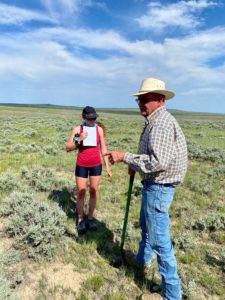
Though I am originally from a beach town, riding into the Bonogofsky ranch immediately felt like home. As the late afternoon sun began to slowly descend, I sat in a circle with my Cycle the Rockies classmates and Alexis Bonogofsky, a Montana rancher and environmental activist. Alexis told us about her origins in activism and how she felt the pull of it when a coal mine and coal trains were proposed on the ancestral lands of the Northern Cheyenne. Having previously worked with Native Americans near her community, Alexis had myriad experiences and relationships with them. These ties drove Alexis to take up the fight against the coal train for nearly a decade to protect the people and their land. Alexis grew teary as she retold the story of the movement that consumed her life for so many years. As I sat there listening to her, I found that spark within myself. I remember her saying, “You need to pick a place and fight for it”and “make the invisible visible.” That is exactly what I want to do. But I didn’t really know where to begin.
Ed Gulick, a green architect, showed us his vision of a more livable community on a bike tour around Billings. His team restores historic buildings to be energy efficient and groovy. He advocates for walkable cities. They are safer, more valuable, and they attract new businesses.
His key to restoring historic buildings is to listen to them. What is the building’s potential? The bike tour that we took with Ed showed us these ideas in action. Hearing Ed talk about his passion for the green development of his community revealed not just the positives of “walkability,” but also the crucial aspect of restoring buildings into places that people will love again.
Ed draws inspiration from the buildings and is moved to make a building what it will be by listening to it. Bridging the gap between building use and the community also starts with listening. This theme of listening has come up several times. It leads people to pursue their passions to benefit people and the environment.
Steve Charter listens to the soil. We spent time on his ranch learning about regenerative ranching. Standing in one of his pastures as he carried his shovel, we walked around for about two sun-scorched hours discussing the importance of soil health by digging it up, feeling and smelling it. Steve would often begin on one topic and then turn toward another, which truly showed the understanding that he has regarding the land. These tangents all connected in the end. Though he has this wealth of knowledge, he stated that “it’s okay to not know everything, and that if you think you do, it can be hard to accept new information, making you more close-minded.”
“What I knew 20 years ago, today is wrong and what I know now will be wrong 20 years from now,” Charter said. He meant he would always be learning.
Again, I was struck by this new perspective on what it means to have a lot of knowledge about something but to always be a student of the Earth and ultimately be listening to what it needs. Alexis Bonogofsky brings people together to fight for justice. Ed Gulick restores buildings for a greener community. Steve Charter uses innovative efforts to maintain healthy soil. All of these accomplished activists have the intuition to listen and then to act off of what they have learned from the environment they are working with. I cannot imagine that this happened overnight for them, but after having discussions with all of them I find myself in a better position to begin truly listening to what the Earth is telling me, and to put my energy into what I care about most regarding the environment.
One Reply to “The Power of Listening by Hannah Espenschied”
Comments are closed.
Wow Hannah, that was truly insightful.
It is so inspiring to hear about people that really care about their environment and dedicate their lives to it. Thank you for sharing your adventure.